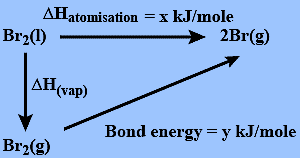
If the enthalpy of atomization for \[B{r_2}(l)\] is x kJ/mol and bond enthalpy for \[B{r_2}(l)\] : is y kJ/mol, the relation between them:
A.does not exist
B.is \[x = y\]
C.is \[x > y\]
D.is \[x < y\]
Answer
469.8k+ views
Hint: Halogens are the most electronegative atoms of each period of the periodic table. Top to bottom of the halogen group size increases because of the number of electrons as well as the number of shells increases. Now with increasing the number of shells their atomic mass is also increases
But bromine is in the middle of the group and also the molecular mass of from is not large to be solid as well as low to be gas. Due to this reason, the physical state of bromine is liquid at room temperature.
Complete step by step answer:
Bond dissociation enthalpy or simply bond enthalpy is the amount of energy required to break the bond between two atoms or two species. To put it in simpler terms, we can say that the bond dissociation enthalpy is a certain amount of energy we supply to a given molecule, which is capable of countering the forces of attraction between the two atoms and thus breaking the bond.
Enthalpy of atomization is the amount of energy required for 1 mole of substance dissociates completely into individual atoms.
Now for the enthalpy of atomization, the \[B{r_2}(l)\] molecule is converted into Br(g) atom. But in case of enthalpy of bond dissociation the \[B{r_2}(g)\] into Br(g) atom.
Therefore, we can say that the enthalpy of atomization is the sum of enthalpy of vaporization and enthalpy of bond dissociation. The diagram is shown below,

So, from the diagram, we can write,
\[
\Delta {H_{atomisation}} = \Delta {H_{vap}} + B.E \\
x = \Delta {H_{vap}} + y \\
\]
Therefore, the value of \[x > y\] .
The correct answer option C.
Note:Some factors affect the bond dissociation enthalpy of compounds:
1.The size of the atom determines the bond dissociation enthalpy. Bigger atoms require more energy to break their bonds because their bond lengths are big as well
2.The greater the multiplicity of a given bond, the greater would be the amount of energy required to break it
3.The presence of lone pairs of electrons decreases the bond enthalpy
4.Atoms with higher electronegativity require higher amounts of energy to break the bonds between them.
But bromine is in the middle of the group and also the molecular mass of from is not large to be solid as well as low to be gas. Due to this reason, the physical state of bromine is liquid at room temperature.
Complete step by step answer:
Bond dissociation enthalpy or simply bond enthalpy is the amount of energy required to break the bond between two atoms or two species. To put it in simpler terms, we can say that the bond dissociation enthalpy is a certain amount of energy we supply to a given molecule, which is capable of countering the forces of attraction between the two atoms and thus breaking the bond.
Enthalpy of atomization is the amount of energy required for 1 mole of substance dissociates completely into individual atoms.
Now for the enthalpy of atomization, the \[B{r_2}(l)\] molecule is converted into Br(g) atom. But in case of enthalpy of bond dissociation the \[B{r_2}(g)\] into Br(g) atom.
Therefore, we can say that the enthalpy of atomization is the sum of enthalpy of vaporization and enthalpy of bond dissociation. The diagram is shown below,

So, from the diagram, we can write,
\[
\Delta {H_{atomisation}} = \Delta {H_{vap}} + B.E \\
x = \Delta {H_{vap}} + y \\
\]
Therefore, the value of \[x > y\] .
The correct answer option C.
Note:Some factors affect the bond dissociation enthalpy of compounds:
1.The size of the atom determines the bond dissociation enthalpy. Bigger atoms require more energy to break their bonds because their bond lengths are big as well
2.The greater the multiplicity of a given bond, the greater would be the amount of energy required to break it
3.The presence of lone pairs of electrons decreases the bond enthalpy
4.Atoms with higher electronegativity require higher amounts of energy to break the bonds between them.
Recently Updated Pages
Can anyone list 10 advantages and disadvantages of friction

What are the Components of Financial System?

How do you arrange NH4 + BF3 H2O C2H2 in increasing class 11 chemistry CBSE

Is H mCT and q mCT the same thing If so which is more class 11 chemistry CBSE

What are the possible quantum number for the last outermost class 11 chemistry CBSE

Is C2 paramagnetic or diamagnetic class 11 chemistry CBSE

Trending doubts
10 examples of friction in our daily life

The correct order of melting point of 14th group elements class 11 chemistry CBSE

Difference Between Prokaryotic Cells and Eukaryotic Cells

One Metric ton is equal to kg A 10000 B 1000 C 100 class 11 physics CBSE

What is the specific heat capacity of ice water and class 11 physics CBSE

State and prove Bernoullis theorem class 11 physics CBSE




